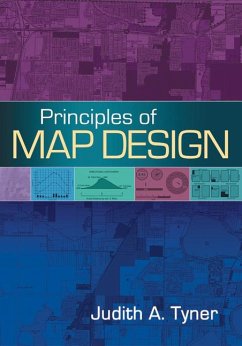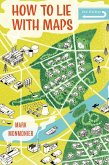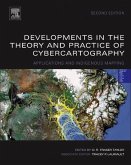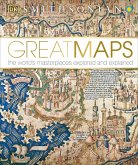This authoritative, reader-friendly text presents core principles of good map design that apply regardless of production methods or technical approach. The book addresses the crucial questions that arise at each step of making a map: Who is the audience? What is the purpose of the map? Where and how will it be used? Students get the knowledge needed to make sound decisions about data, typography, color, projections, scale, symbols, and nontraditional mapping and advanced visualization techniques.
Â
Pedagogical Features:
_Over 200 illustrations (also available at the companion website as PowerPoint slides), including 23 color plates
_Suggested readings at the end of each chapter.
_Recommended Web resources.
_Instructive glossary
Hinweis: Dieser Artikel kann nur an eine deutsche Lieferadresse ausgeliefert werden.
Â
Pedagogical Features:
_Over 200 illustrations (also available at the companion website as PowerPoint slides), including 23 color plates
_Suggested readings at the end of each chapter.
_Recommended Web resources.
_Instructive glossary
Hinweis: Dieser Artikel kann nur an eine deutsche Lieferadresse ausgeliefert werden.
"From a respected cartographer, this is a well-written and easy-to-understand textbook for an introductory course in cartography or map design. A major advantage of this book is that it does not focus on specific GIS software; rather, the design principles can be applied to any GIS software used to make maps. Design considerations for exciting new mapping technologies--such as web mapping, animated and interactive maps, and maps for the visually impaired--are also covered."--Michael Leitner, PhD, Department of Geography and Anthropology, Louisiana State University; Editor, Cartography and Geographic Information Science
"Tyner draws on years of experience to return a design-driven approach to the introductory cartography text. She weaves together practical and theoretical considerations in discussions that focus on an understanding of meaning rather than memorization of definitions and equations. Instructors will find the chapter featuring six 'map makeovers' to be particularly useful for teaching students the crucial skills of map editing and redesign."--Margaret Pearce, PhD, Department of Geography, Ohio University
"As map design increasingly becomes dictated by software default options, students and professionals need a better grounding in the basic principles and conventions of cartography. Using numerous graphic examples, Tyner shows how to make appropriate design choices to effectively communicate spatial information."--Dennis Fitzsimons, PhD, Geography Department, Humboldt State University
"Tyner has given us a concise, readable book that summarizes principles of map design. It will be especially valuable to those specializing in GIS who want a clear working knowledge of map planning, symbols, typography, and common thematic maps."--Eugene Turner, PhD, Department of Geography, California State University, Northridge-Judith Tyner is eminently qualified to provide us with a textbook of this ilk having taught all aspects of cartography over approximately 35 years, spanning the most interesting and fast changing period of development in modern cartography. This book brings us right up to date in a clear and readable manner supporting the traditional principles many feel have been lost in the growing output of mapping from Geographic Information Systems....With the decline of college and university courses teaching cartography, and the increasing use of maps in many guises both in the work place and for recreational use, there is a need for a good textbook to bring practitioners up to date, and also to reinvigorate the principles of good design in the cartographic process. Judith Tyner's book provides just such a text, and it is also well illustrated with a pleasingly clean design and layout.--Society of Cartographers Bulletin, 3/5/2010 This clearly written textbook focuses on the principles of making maps. Not a how-to book, its goal is translating and summarizing current cartographic thought and practice and making this information accessible to students.--ArcUser, 9/19/2010
"Tyner draws on years of experience to return a design-driven approach to the introductory cartography text. She weaves together practical and theoretical considerations in discussions that focus on an understanding of meaning rather than memorization of definitions and equations. Instructors will find the chapter featuring six 'map makeovers' to be particularly useful for teaching students the crucial skills of map editing and redesign."--Margaret Pearce, PhD, Department of Geography, Ohio University
"As map design increasingly becomes dictated by software default options, students and professionals need a better grounding in the basic principles and conventions of cartography. Using numerous graphic examples, Tyner shows how to make appropriate design choices to effectively communicate spatial information."--Dennis Fitzsimons, PhD, Geography Department, Humboldt State University
"Tyner has given us a concise, readable book that summarizes principles of map design. It will be especially valuable to those specializing in GIS who want a clear working knowledge of map planning, symbols, typography, and common thematic maps."--Eugene Turner, PhD, Department of Geography, California State University, Northridge-Judith Tyner is eminently qualified to provide us with a textbook of this ilk having taught all aspects of cartography over approximately 35 years, spanning the most interesting and fast changing period of development in modern cartography. This book brings us right up to date in a clear and readable manner supporting the traditional principles many feel have been lost in the growing output of mapping from Geographic Information Systems....With the decline of college and university courses teaching cartography, and the increasing use of maps in many guises both in the work place and for recreational use, there is a need for a good textbook to bring practitioners up to date, and also to reinvigorate the principles of good design in the cartographic process. Judith Tyner's book provides just such a text, and it is also well illustrated with a pleasingly clean design and layout.--Society of Cartographers Bulletin, 3/5/2010 This clearly written textbook focuses on the principles of making maps. Not a how-to book, its goal is translating and summarizing current cartographic thought and practice and making this information accessible to students.--ArcUser, 9/19/2010








